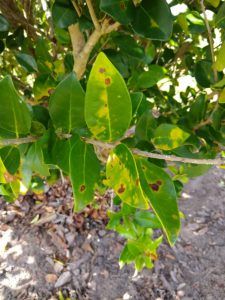 All of the wet weather that we experienced this summer created the perfect environment for fall fungal and bacterial leaf spots. Typically predominant in the late summer and fall, these diseases can especially affect plants in poor health, in dense plantings, in shady conditions or when plants may be nearing the end of their life. Leaf spots can cause a variety of symptoms including spots of various colors, premature leaf drop and general thinning of foliage.
All of the wet weather that we experienced this summer created the perfect environment for fall fungal and bacterial leaf spots. Typically predominant in the late summer and fall, these diseases can especially affect plants in poor health, in dense plantings, in shady conditions or when plants may be nearing the end of their life. Leaf spots can cause a variety of symptoms including spots of various colors, premature leaf drop and general thinning of foliage.
It is a good idea to have the leaf spot identified if you are not sure which one it is. Many plants are susceptible to a certain leaf spot – for instance, ligustrum is susceptible to Cercospora leaf spot. Management recommendations include adjusting the irrigation schedule to avoid more water in addition to rainfall. If possible, avoid overhead irrigation, and/or water early in the day. Avoid excessive pruning of hedges. When using approved fungicides, be sure to get good coverage.
From the UF/IFAS publication Professional Disease Management Guide for Ornamental Plants: Systemic fungicides usually move upward within a plant, though there are a few that also move downward. They may be applied as foliar sprays, soil drenches, or tree injections. Locally systemic fungicides have limited mobility in the direct vicinity of application. Almost all systemic fungicides disrupt only one or a few steps in fungal metabolism. Therefore, resistance to these chemicals usually occurs within a few years if used frequently. It is best to use these products in combination or rotation with broad-spectrum contact fungicides to delay development of resistance. Advantages of using systemic fungicides include longer residual activity and survival of possible beneficial organisms on the plant surface.
Fungicides may have protective or curative activity. Most fungicides and bactericides are protectants and must be present on or in the plant in advance of the pathogen in order to prevent infection. These chemicals may be applied when environmental conditions are conducive to a disease outbreak. Products with curative activity may be applied after infection but prior to severe disease symptoms. Some chemicals have both protective and curative activity that may depend on the rate of application. Resistance to many contact pesticides is slow to develop or nonexistent because many different metabolic pathways of target organisms are disrupted.
More disease management recommendations here: http://edis.ifas.ufl.edu/pp123
 1
1
